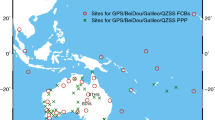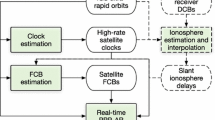Abstract
The main challenge of dual-frequency precise point positioning (PPP) is that it requires about 30 min to obtain centimeter-level accuracy or to succeed in the first ambiguity-fixing. Currently, PPP is generally conducted with GPS only using the ionosphere-free combination. We adopt a single-differenced (SD) between-satellite PPP model to combine the GPS and GLONASS raw dual-frequency carrier phase measurements, in which the GPS satellite with the highest elevation is selected as the reference satellite to form the SD between-satellite measurements. We use a 7-day data set from 178 IGS stations to investigate the contribution of GLONASS observations to both ambiguity-float and ambiguity-fixed SD PPP solutions, in both kinematic and static modes. In ambiguity-fixed PPP, we only attempt to fix GPS integer ambiguities, leaving GLONASS ambiguities as float values. Numerous experimental results show that PPP with GLONASS and GPS requires much less convergence time than that of PPP with GPS alone. For ambiguity-float PPP, the average convergence time can be reduced by 45.9 % from 22.9 to 12.4 min in static mode and by 57.9 % from 40.6 to 17.7 min in kinematic mode, respectively. For ambiguity-fixed PPP, the average time to the first-fixed solution can be reduced by 27.4 % from 21.6 to 15.7 min in static mode and by 42.0 % from 34.4 to 20.0 min in kinematic mode, respectively. Experimental results also show that the less the GPS satellites are used in float PPP, the more significant is the reduction in convergence time when adding GLONASS observations. In addition, on average, more than 4 GLONASS satellites can be observed for most 2-h observation sessions. Nearly, the same improvement in convergence time reduction is achieved for those observations.

















Similar content being viewed by others
References
Bisnath, S., Gao, Y (2007). Current state of precise point positioning and future prospects and limitations. Proceedings of Observing our Changing Earth. IAG Symposium Series, 133, 615–624
Blewitt G (1989) Carrier phase ambiguity resolution for the global positioning system applied to geodetic baselines up to 2000 km. J Geophys Res 94(B8):10187–10203
Cai C, Gao Y (2013) Modeling and assessment of combined GPS/GLONASS precise point positioning. GPS Solut 17(2):223–236
Calais E, Han JY, DeMets C, Nocquet JM et al (2006) Deformation of the North American plate interior from a decade of continuous GPS measurements. J Geophys Res 111:B6402
Colombo OL, Evans AG, Ando M, Tadokoro K, Sato K, Yamada T (2001) Speeding up the estimation of floated ambiguities for sub-decimeter kinematic positioning at sea. Proceedings ION-GPS-2001 Institute of Navigation, Salt Lake, US, pp 2980–2989
Dach R, Brockmann E, Schaer S, Beutler G, Meindl M, Prange L, Bock H, Jaggi A, Ostini L (2009) GNSS processing at CODE: status report. J Geodesy 83(3):353–365
Defraigne P, Baire Q (2011) Combining GPS and GLONASS for time and frequency transfer. Adv Sp Res 47(2):265–275
Dow JM, Neilan RE, Rizos C (2009) The international GNSS service in a changing landscape of global navigation satellite systems. J Geodesy 83(3):191–198
Elsobeiey M, El-Rabbany A (2012) On modelling of second-order ionospheric delay for GPS precise point positioning. J Navig 65(1):59–72
Euler H, Schaffrin B (1991) On a measure for the discernibility between different ambiguity solutions in the static-kinematic GPS-mode. Kinematic Systems in Geodesy, and surveying, and remote sensing. Springer, New York, pp 285–295
Ge M, Gendt G, Rothacher M, Shi C, Liu J (2008) Resolution of GPS carrier-phase ambiguities in Precise Point Positioning (PPP) with daily observations. J Geodesy 82(7):389–399
Gendt G, Dick G, Reigber C, Tomassini M, Liu Y, Ramatschi M (2004) Near real time GPS water vapor monitoring for numerical weather prediction in Germany. J Meteorol Soc Jn. Ser. II 82(1B):361–370
Geng J, Teferle FN, Shi C, Meng X, Dodson AH, Liu J (2009) Ambiguity resolution in precise point positioning with hourly data. GPS Solu 13(4):263–270
Geng J, Meng X, Dodson AH, Ge MR, Teferle FN (2010) Rapid re-convergences to ambiguity-fixed solutions in precise point positioning. J Geodesy 84(12):705–714
Geng J, Teferle FN, Meng X, Dodson AH (2011) Towards PPP-RTK: ambiguity resolution in real-time precise point positioning. Adv Sp Res 47(10):1664–1673
Hammond WC, Thatcher W (2005) Northwest basin and range tectonic deformation observed with the global positioning system, 1999-2003. Journal of geophysical research-Solid earth 110(B10405B10)
Hatch Ron (1982) The synergism of GPS code and carrier measurements. Proceedings of the Third International Symposium on Satellite Doppler Positioning at Physical Sciences Laboratory of New Mexico State University, Feb. 8-12, Vol. 2, pp 1213–1231
Jokinen A, Feng S, Milner C, Schuster W, Ochieng W (2011) Precise Point Positioning and Integrity Monitoring with GPS and GLONASS, European Navigation Conference 2011
Jokinen A, Feng S, Schuster W, Ochieng W, Hide C, Moore T, Hill C (2013) GLONASS aided GPS ambiguity fixed precise point positioning. J Navig 66(3):399–416
Li X, Zhang X, Ge M (2011) Regional reference network augmented precise point positioning for instantaneous ambiguity resolution. J Geodesy 85(3):151–158
Li X, Ge M, Zhang H, Nischan T, Wickert J (2013) The GFZ real-time GNSS precise positioning service system and its adaption for COMPASS. Advan Space Res 51(6):1008–1018
Melbourne WG (1985) The case for ranging in GPS-based geodetic systems. In: Proceedings first international symposium on precise positioning with the global positioning system, Rockville, 15–19 Apr, pp 373–386
Piriz, R., Calle, D., Mozo, A., Navarro, P., Rodrıguez, D., Tobıas, G (2009). Orbits and clocks for GLONASS precise point positioning, Proceedings ION-GNSS-2009, Institute of Navigation, Savannah, Georgia, pp. 2415-2424, Sept 22–25
Rebischung P, Griffiths J, Ray J, Schmid R, Collilieux X, Garayt B (2012) IGS08: the IGS realization of ITRF2008. GPS Sol 16(4):483–494
Reussner N, Wanninger L. (2011). GLONASS Inter-frequency biases and their effects on RTK and PPP carrier phase ambiguity resolution. Proceedings ION-GNSS-2011, Institute of Navigation. Portland, OR, 712–716
Revnivykh S (2010) GLONASS Status and Progress. Proceedings ION-GNSS-2010, Institute of Navigation. pp 609–633
Rocken C, Johnson J, Van Hove T, Iwabuchi T (2005) Atmospheric water vapor and geoid measurements in the open ocean with GPS. Geophys Res Lett 32(12):L12813
Seeber G (2003) Satellite geodesy: foundations, methods, and applications. de Gruyter
Sleewaegen JM, Simsky A, de Wilde W, Boon F, Willems T (2012) Demystifying GLONASS inter-frequency carrier phase biases. InsideGNSS 7(3):57–61
Teunissen PJG (1994) A new method for fast carrier phase ambiguity estimation. In: Proceedings of IEEE position, location and navigation symposium, Las Vegas, NV, Apr 11–15, pp 562–573, 1994
Teunissen PJG, Joosten P, Odijk D (1999) The reliability of GPS ambiguity resolution. GPS Solu 2(3):63–69
Tolman, B.W., Kerkhoff, A., Rainwater, D., Munton, D., Banks, J (2010). Absolute precise kinematic positioning with GPS and GLONASS, Proceedings ION-GNSS-2010, Institute of Navigation, Portland, Oregon, pp. 2565–2576, September 21–24
Verhagen, S., Teunissen, P.J.G., Van der Marel, H. & Li, B. (2011), “GNSS ambiguity resolution: which subset to fix?”, In: Proceedings of International Global Navigation Satellite Systems Society, IGNSS Symposium 2011, pp. 1–15
Wang J, Feng YM (2013) Reliability of partial ambiguity fixing with multiple GNSS constellations. J Geodesy 87(1):1–14
Wu JT, Wu SC, Hajj GA, Bertiger WI, Lichten SM (1993) Effects of antenna orientation on GPS carrier phase. Manuscripta Geodaetica 18(2):91–98
Wubbena G (1985) Software developments for geodetic positioning with GPS using TI-4100 code and carrier measurements. In: Proceedings of first international symposium on precise positioning with the global positioning system, Rockville, 15–19 Apr, pp 403–412
Zhang XH, Li P (2013) Assessment of correct fixing rate for precise point positioning ambiguity resolution on global scale. J Geodesy 87(6):579–589
Zhang XH, Li P, Guo F (2013) Ambiguity resolution in precise point positioning with hourly data for global single receiver. Adv Space Res 51(1):153–161
Zumberge JF, Heflin MB, Jefferson DC, Watkins MM, Webb FH (1997) Precise point positioning for the efficient and robust analysis of GPS data from large networks. J Geophys Res 102(3):5005–5017
Acknowledgments
This study was supported by National 973 Project China (Grant No. 2013CB733301) and National Natural Science Foundation of China (Grant No. 41074024, No. 41204030) and the Fundamental Research Funds for the Central Universities (No.: 2012214020207). The authors are grateful to many individuals and organizations worldwide who contribute to the International GNSS Service.
Author information
Authors and Affiliations
Corresponding author
Rights and permissions
About this article
Cite this article
Li, P., Zhang, X. Integrating GPS and GLONASS to accelerate convergence and initialization times of precise point positioning. GPS Solut 18, 461–471 (2014). https://doi.org/10.1007/s10291-013-0345-5
Received:
Accepted:
Published:
Issue Date:
DOI: https://doi.org/10.1007/s10291-013-0345-5




